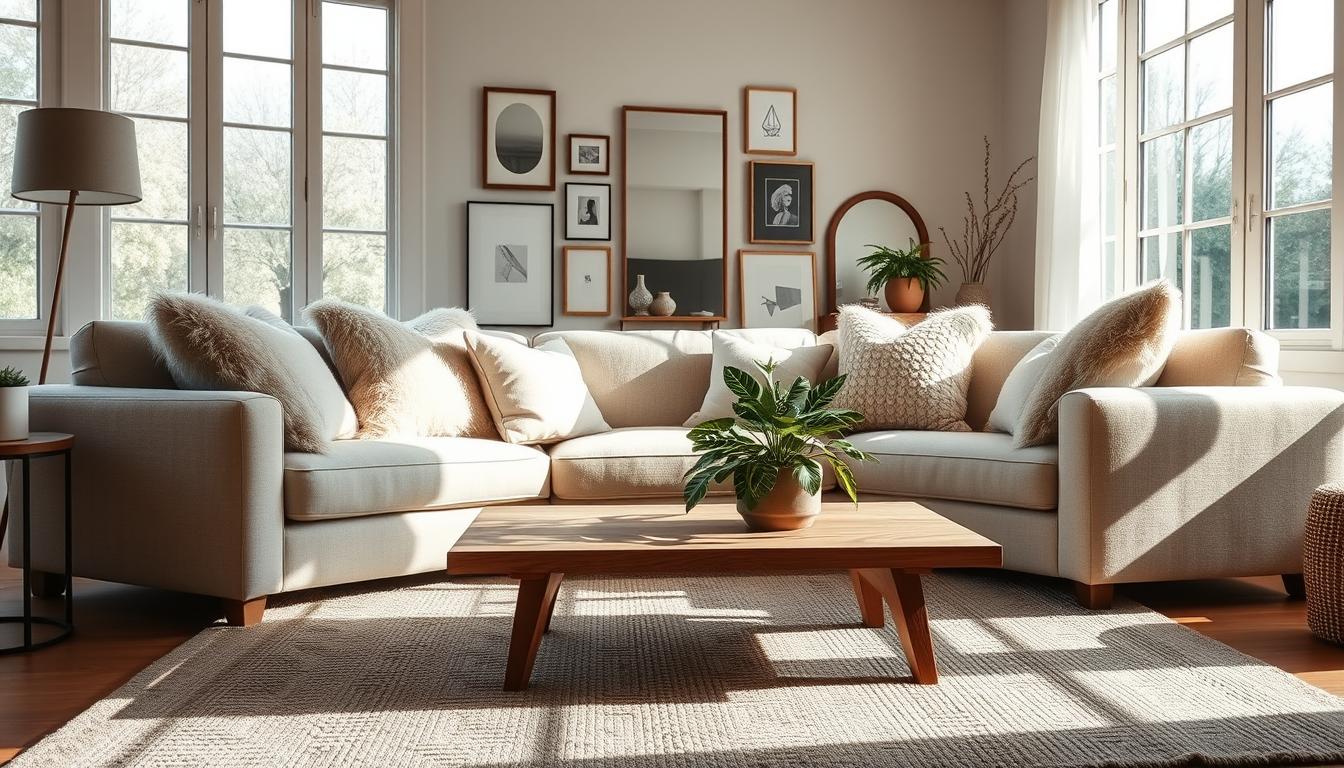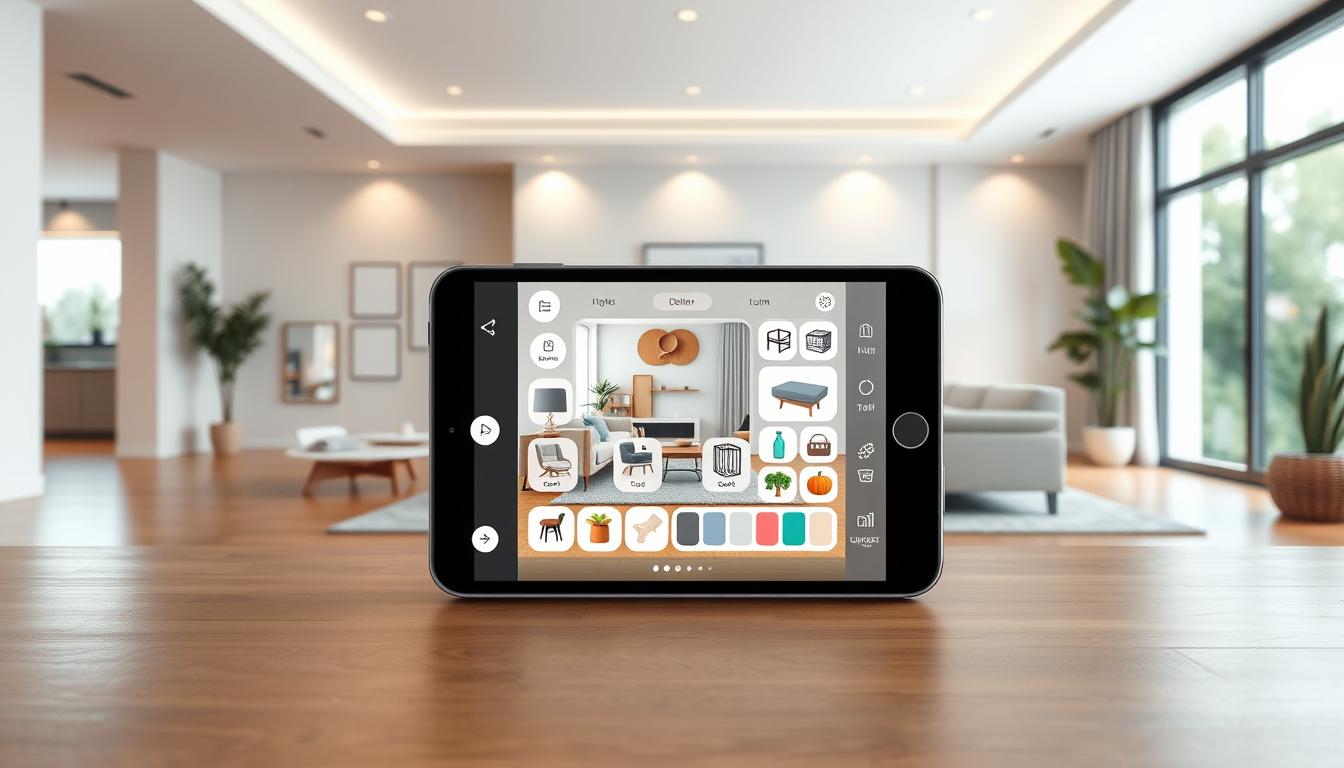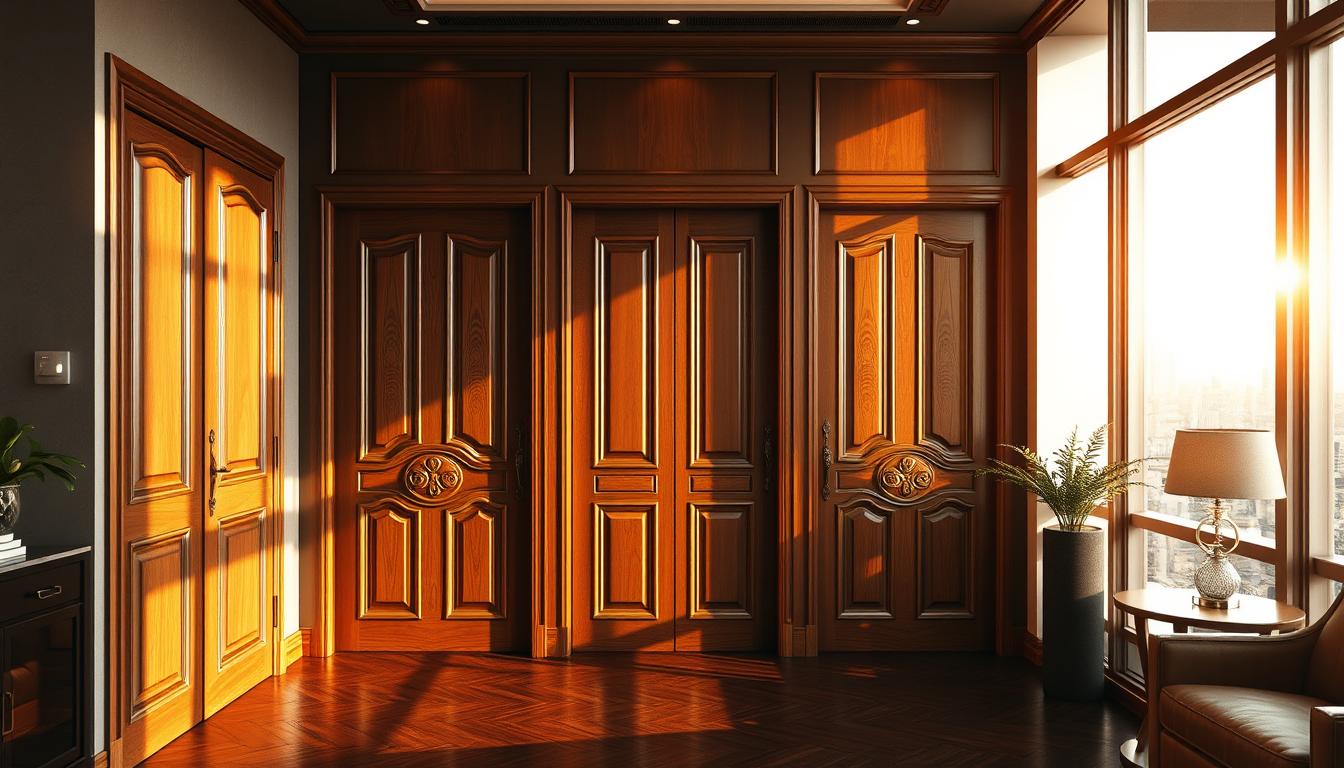Did you know a well-designed living space can make you happier and more productive? As we dive into home decor inspiration, we find many ideas to turn any room into a cozy and stylish place.
We’ll show you how to mix minimalism with smart tech. Our aim is to share the top home and interior design ideas that look great and work well.
Key Takeaways
- Explore the latest trends in home decor inspiration
- Discover how to incorporate smart technology into your design
- Learn the benefits of minimalism in interior design
- Find out how to balance style and functionality
- Get tips on elevating your living space’s aesthetic
Embracing Minimalism in Home Design
Minimalist home design is more than a trend. It’s a lifestyle that values simplicity and function. It aims to create a calm, clutter-free space that encourages relaxation and focus.
The Philosophy Behind Minimalism
The core of minimalism is “less is more.” This means each item in a room must have a purpose. It eliminates clutter and focuses on simplicity and clean lines.
Minimalism is about simplicity and purpose. It’s about choosing items that enhance both the look and function of your space. This approach reduces stress and boosts well-being by making your home more organized and peaceful.
How to Start with Minimalist Decor
To begin with minimalist decor, start by decluttering. Remove items that are no longer needed or serve no purpose. Use a neutral color palette and choose furniture and decor with clean lines. Here are some interior decorating tips to help you:
- Start with a neutral base: Use a neutral color on walls and floors to create a calm backdrop.
- Choose multi-functional furniture: Pieces that serve more than one purpose can help reduce clutter.
- Limit decorative items: Select a few meaningful pieces rather than displaying a large collection.
- Emphasize natural light: Make the most of natural light to brighten up your space.
By following these steps and embracing minimalism, you can create a home that reflects modern home design trends. Your home will be calm and clear.
Understanding Color Psychology in Interiors
Color psychology is key in interior design. It affects how we feel and interact in our homes. The colors we pick can change our mood, energy, and well-being. By knowing the effects of colors, we can make spaces that look good and feel good.
Choosing the Right Palette for Each Room
Choosing colors for your home depends on the room’s purpose and the mood you want. Calming colors like blues and greens are great for bedrooms. They help us relax and sleep better. On the other hand, bright colors like oranges and yellows energize living areas. They’re perfect for entertaining or family time.
When using creative interior design concepts, think about the room’s natural light. It changes how colors look. The 60-30-10 rule is helpful: 60% of the room is a main color, 30% a secondary, and 10% an accent. This balance makes the room look good and feel right.
Accent Walls: Making a Statement
Accent walls are a great way to add color and interest. A bold, contrasting color on one wall can highlight a feature, like a fireplace. This adds depth and lets you use cozy home styling tips to make the room warm and inviting.
When doing accent walls, make sure the color fits with the room’s scheme. You can also play with textures and patterns to make it even more interesting.
Sustainable Design: Eco-Friendly Choices
Homeowners are now looking for stylish home renovation ideas that are good for the planet. Making eco-friendly choices helps the environment and makes our homes look and work better.
When we talk about sustainable design, picking the right materials is key. Eco-friendly materials help lessen our project’s environmental impact.
Materials That Make a Difference
It’s important to choose the right materials for sustainable design. Some top choices include:
- Reclaimed wood
- Bamboo
- Low-VOC paints
- Recycled metal
| Material | Environmental Benefit | Cost Effectiveness |
|---|---|---|
| Reclaimed Wood | Reduces waste and preserves history | Moderate to High |
| Bamboo | Fast-growing, renewable resource | Moderate |
| Low-VOC Paints | Improves indoor air quality | Low to Moderate |
For more interior design advice, including how to use these materials, check our website.
Implementing Energy-Efficient Solutions
Energy efficiency is key in sustainable design. It helps cut down on carbon emissions and lowers utility bills.
Some good strategies include:
- Upgrading to LED lighting
- Installing energy-efficient appliances
- Improving insulation
- Investing in solar panels
By using these budget-friendly home decor hacks and eco-friendly practices, we can make beautiful, green spaces. These spaces are both functional and stylish.
The Power of Lighting in Home Design
Lighting in home design is more than just turning on the lights. It’s about setting a mood that shows off our style. It changes how a room feels and works, making it key in innovative interior design solutions.
Natural and artificial light both matter in home design. Natural light makes rooms feel bigger and more inviting. Artificial light, on the other hand, boosts beauty and use, like at night or in dark spots.
Natural Light vs. Artificial Lighting
Natural light is perfect for most rooms because it feels warm and connects us to nature. But, it’s not always easy to get. That’s why we need artificial light too. Artificial lighting solutions have improved a lot, offering many types. This lets homeowners pick the right light for different times and activities.
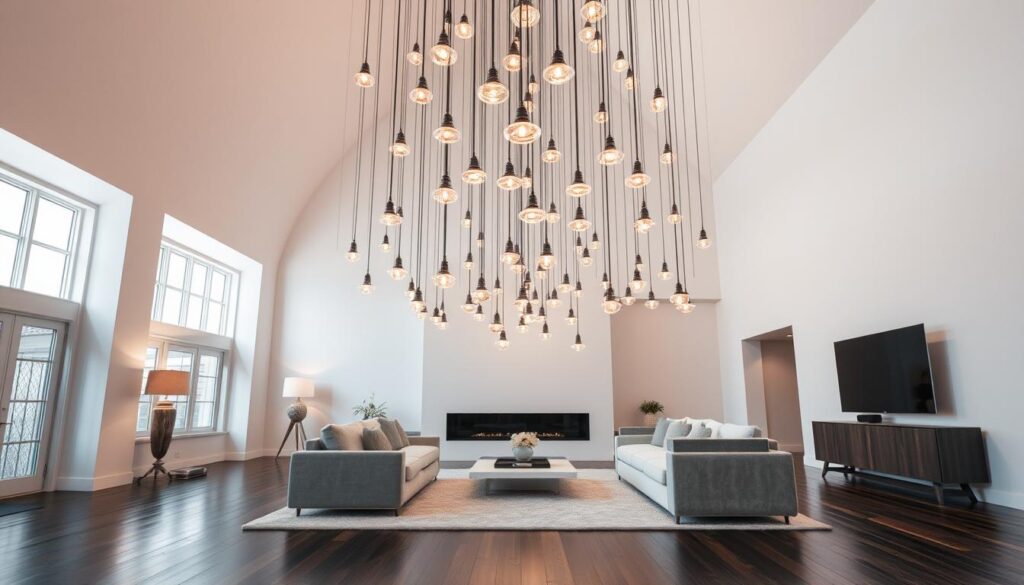
Choosing the Right Fixtures for Each Space
Picking the right lights is key for the look you want in each room. For example, a living room might need table and floor lamps for a cozy feel. A kitchen, though, needs bright lights for cooking and food prep.
Think about your home’s style and what each room needs when picking lights. Innovative lighting solutions can include smart systems that change with the time or activity. This makes your home both pretty and practical.
Knowing how lighting works and making smart choices can really improve your home. It makes spaces that are not just good-looking but also useful.
Personalizing Your Space with Art
Adding art to your home decor can really enhance the feel of your space. It can make your home reflect your unique style and personality. We’ll show you how to set up a stunning gallery wall and help you pick art that fits your home’s look, giving you home decor inspiration.
Gallery Walls: Tips and Tricks
Building a gallery wall is a great way to showcase your favorite pieces. Here are some tips to keep in mind:
- Plan Ahead: Before you start, plan your gallery wall. Use a floor or a large table to lay out your frames.
- Unify with Color: Pick frames that match in color and style for a cohesive look.
- Mix and Match: Feel free to mix different frame styles and sizes for interest.
Selecting the Right Artwork for Your Style
Choosing art that speaks to you can add a lot to your space. Think about these points:
- Reflect Your Personality: Pick art that shows who you are or what you’re into.
- Consider the Room’s Purpose: Choose art that fits the room’s purpose. For instance, a calm piece for a bedroom or a lively piece for a living room.
- Experiment with Different Styles: Don’t shy away from mixing art styles for a unique look.
By using these tips, you can make a space that feels truly like home. It will be filled with art that inspires and brings joy.
Open Concept Living: Is It Right for You?
Open concept living is more than a design trend. It’s a lifestyle choice that affects our daily lives. When looking at modern home design trends, we must consider the good and bad of open floor plans.
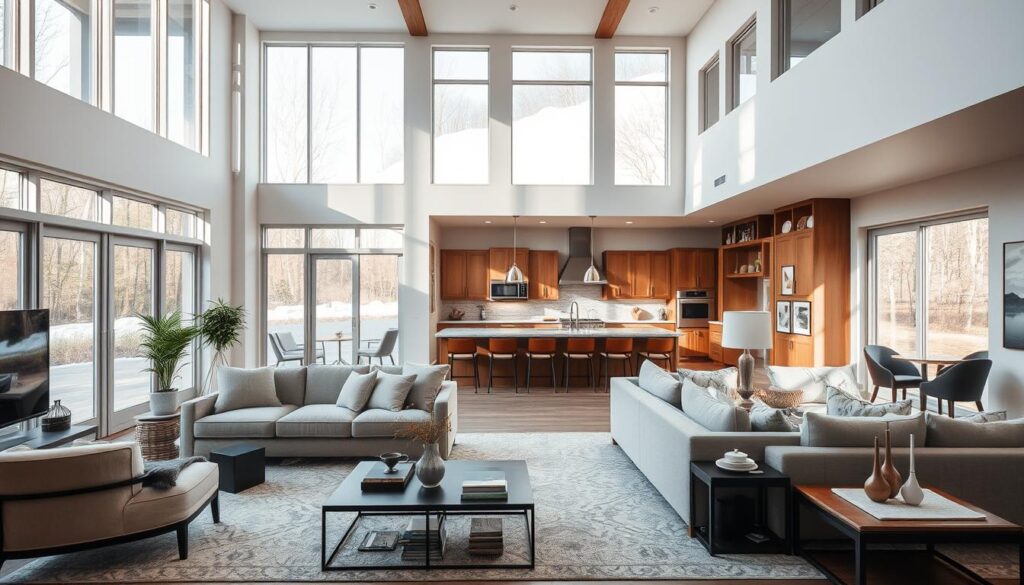
Open concept living brings a sense of spaciousness. It removes barriers between rooms, making our homes feel airy and open. This design also encourages family and guests to interact, breaking down the isolation of separate rooms.
Pros and Cons of Open Floor Plans
Let’s look at the good and bad of open floor plans in our homes.
- Advantages:
- More space and airflow
- Better social interaction
- Flexibility in arranging furniture
- Disadvantages:
- Noise levels might increase
- Privacy could be lost
- It’s hard to define separate areas
To enjoy an open concept living space, finding a balance is key. We can use area rugs, different lighting, and smart furniture placement. These help create separate zones in the open area.
Whether open concept living fits your lifestyle depends on your needs and preferences. By weighing the pros and cons, we can choose what’s best for us.
Creating Functional Spaces for Work and Play
Remote work and homeschooling have made versatile home designs more important than ever. We need spaces that help us work well and play better. It’s key to make areas that boost productivity and spark creativity.
Designing a Home Office That Inspires
A good home office is vital for staying motivated and productive. Here are some interior decorating tips to make your workspace inspiring:
- Choose a spot with few distractions.
- Make sure it has natural light and comfy furniture.
- Use colors that help you focus.
- Add your own touch with art and plants.
For more tips on a productive home office, check out our guide on top home office interior design ideas.
Fun and Functional Play Areas for Kids
A play area that’s both fun and useful is great for kids’ growth. Here are some cozy home styling tips to think about:
- Go for bright colors to spark creativity.
- Include comfy seats and smart storage.
- Set up areas for reading, crafting, and play.
By designing these spaces carefully, we can make our homes better for everyone. This boosts our happiness and well-being.
Incorporating Textures for Depth and Interest
Adding different textures to your home makes it feel richer and more welcoming. Texture is key in creative interior design concepts. It brings depth and interest to any room.
When designing our homes, we usually think about colors and furniture. But texture is just as important for a cozy feel. Mixing various textures creates a balanced and engaging decor.
Layering Fabrics in Living Spaces
One easy way to add texture is by layering fabrics. Use throw blankets, rugs, and pillows in different materials. For example, velvet pillows with chunky knit throws look great together.
To layer fabrics well, start with a rug. Then add textures through furniture and decor. This method adds depth and defines areas in open-plan spaces.
Using Natural Elements for Warmth
Natural elements like wood, stone, and plants also warm up your home. They bring the outdoors in, making your space cozy and organic. A wooden coffee table or a stone fireplace can be a room’s centerpiece. Adding plants brings in greenery and freshness.
Think about the look you want when using natural elements. For a rustic vibe, go for reclaimed wood and earthy tones. For modern, use natural materials in sleek designs.
By carefully adding textures and natural elements, we make our homes beautiful and inviting. This way of creative interior design concepts lets us create spaces that show our style and make our lives better.
Smart Home Technology for Modern Living
Smart home technology is changing how we live and interact with our homes. It’s not just about making things easier. It’s about making our homes more efficient, secure, and comfortable.
Smart home devices make our lives simpler. They include voice-controlled assistants and automated lighting. These innovative interior design solutions turn homes into futuristic spaces.
Gadgets That Enhance Home Automation
Many gadgets are leading in home automation. These include:
- Voice-controlled assistants like Amazon Alexa and Google Home
- Smart thermostats that learn your temperature preferences
- Automated lighting systems that adjust based on occupancy and time of day
- Smart security cameras and doorbells with facial recognition
These devices improve your home’s functionality. They also add to stylish home renovation ideas by blending technology with decor.
Balancing Tech with Aesthetic Appeal
Technology is key in modern living, but so is keeping your home looking good. Here are some tips to mix tech with style:
- Choose devices with sleek designs that match your decor.
- Hide wires and cables for a clean look.
- Make technology part of your furniture and fixtures.
By following these tips, you can enjoy smart home tech without losing style. You’ll get a perfect mix of function and beauty in your home.
Trendy Design Styles to Consider
Updating your home with the latest trends doesn’t have to cost a lot. Here are some affordable home decor tips. Two popular styles are Industrial and Scandinavian aesthetics.
Industrial design uses raw materials for a cool look. It often includes exposed brick, metal beams, and reclaimed wood. To add Industrial style to your home, think about these elements:
Industrial: Embracing Raw Materials
- Exposed ductwork and brick walls
- Metal accents and reclaimed wood furniture
- Minimal ornamentation, focusing on functionality
Scandinavian design is all about warmth and simplicity. It’s known for being minimalist, focusing on function and comfort. To bring Scandinavian style into your home, consider:
Scandinavian: Warmth and Simplicity
- Light-colored woods and neutral color palettes
- Cozy textiles and plush furnishings
- Minimalist decor with a focus on functionality
Both styles offer unique looks that can be mixed for a personal touch. For example, combining Industrial metal accents with Scandinavian textiles creates a welcoming space.
| Design Element | Industrial Style | Scandinavian Style |
|---|---|---|
| Color Palette | Neutral with dark accents | Light and neutral |
| Materials | Exposed brick, metal, reclaimed wood | Light-colored woods, textiles |
| Furniture | Minimal, functional, often metal or reclaimed wood | Simple, functional, with an emphasis on comfort |
Understanding these design styles helps you create a stylish, functional home. Whether you prefer Industrial’s edgy charm or Scandinavian’s warmth, there are affordable ways to add these trends to your decor.
Tips for Mixing and Matching Styles
Mixing different design styles is an art. It lets you make your space unique. When done right, it shows your personality and tells a story.
Discovering Your Style
To mix styles well, first find what you like. Try out various designs until you find your favorite. Think about what makes you feel at home and adds coziness.
Blending Old and New
Old and new together add character. You can mix vintage furniture with modern decor. Or, add antique pieces to a modern space. This mix creates a unique look that’s both stylish and cozy.
By trying out these tips and exploring different styles, you can make a space that’s beautiful and shows your taste.

